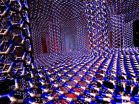(Press-News.org) HOUSTON - (July 15, 2015) - Three-dimensional structures of boron nitride might be the right stuff to keep small electronics cool, according to scientists at Rice University.
Rice researchers Rouzbeh Shahsavari and Navid Sakhavand have completed the first theoretical analysis of how 3-D boron nitride might be used as a tunable material to control heat flow in such devices.
Their work appears this month in the American Chemical Society journal Applied Materials and Interfaces.
In its two-dimensional form, hexagonal boron nitride (h-BN), aka white graphene, looks just like the atom-thick form of carbon known as graphene. One well-studied difference is that h-BN is a natural insulator, where perfect graphene presents no barrier to electricity.
But like graphene, h-BN is a good conductor of heat, which can be quantified in the form of phonons. (Technically, a phonon is one part -- a "quasiparticle" - in a collective excitation of atoms.) Using boron nitride to control heat flow seemed worthy of a closer look, Shahsavari said.
"Typically in all electronics, it is highly desired to get heat out of the system as quickly and efficiently as possible," he said. "One of the drawbacks in electronics, especially when you have layered materials on a substrate, is that heat moves very quickly in one direction, along a conductive plane, but not so good from layer to layer. Multiple stacked graphene layers is a good example of this."
Heat moves ballistically across flat planes of boron nitride, too, but the Rice simulations showed that 3-D structures of h-BN planes connected by boron nitride nanotubes would be able to move phonons in all directions, whether in-plane or across planes, Shahsavari said.
The researchers calculated how phonons would flow across four such structures with nanotubes of various lengths and densities. They found the junctions of pillars and planes acted like yellow traffic lights, not stopping but significantly slowing the flow of phonons from layer to layer, Shahsavari said. Both the length and density of the pillars had an effect on the heat flow: more and/or shorter pillars slowed conduction, while longer pillars presented fewer barriers and thus sped things along.
While researchers have already made graphene/carbon nanotube junctions, Shahsavari believed such junctions for boron nitride materials could be just as promising. "Given the insulating properties of boron nitride, they can enable and complement the creation of 3-D, graphene-based nanoelectronics.
"This type of 3-D thermal-management system can open up opportunities for thermal switches, or thermal rectifiers, where the heat flowing in one direction can be different than the reverse direction," Shahsavari said. "This can be done by changing the shape of the material, or changing its mass - say one side is heavier than the other - to create a switch. The heat would always prefer to go one way, but in the reverse direction it would be slower."
INFORMATION:
Shahsavari is an assistant professor of civil and environmental engineering and of materials science and nanoengineering. Sakhavand is a former graduate student at Rice.
The National Science Foundation and the Rice Department of Civil and Environmental Engineering supported the research. The researchers used the National Science Foundation-supported DAVinCI supercomputer administered by Rice's Ken Kennedy Institute for Information Technology. They also used computing resources supported by the National Institutes of Health, IBM, CISCO, Qlogic and Adaptive Computing.
Read the abstract at http://pubs.acs.org/doi/abs/10.1021/acsami.5b03967
This news release can be found online at http://news.rice.edu/2015/07/14/white-graphene-structures-can-take-the-heat-2/
Follow Rice News and Media Relations via Twitter @RiceUNews
Related Materials:
Shahsavari Group: http://rouzbeh.rice.edu/default.aspx
George R. Brown School of Engineering: http://engineering.rice.edu
Images for download:
http://news.rice.edu/wp-content/uploads/2015/07/07-20-15_BORON-1-web.jpg
A 3-D structure of hexagonal boron nitride sheets and boron nitride nanotubes could be a tunable material to control heat in electronics, according to researchers at Rice University. (Credit: Shahsavari Group/Rice University)
http://news.rice.edu/wp-content/uploads/2015/07/07-20-15_BORON-2-WEB.jpg
Rice University researchers Rouzbeh Shahsavari (left) and Navid Sakhavand have calculated the flow of heat across simulated structures of hexagonal boron nitride and boron nitride nanotubes. They report such structures may be suitable for controlling heat flow in electronics. (Credit: Jeff Fitlow/Rice University)
Located on a 300-acre forested campus in Houston, Rice University is consistently ranked among the nation's top 20 universities by U.S. News & World Report. Rice has highly respected schools of Architecture, Business, Continuing Studies, Engineering, Humanities, Music, Natural Sciences and Social Sciences and is home to the Baker Institute for Public Policy. With 3,888 undergraduates and 2,610 graduate students, Rice's undergraduate student-to-faculty ratio is 6-to-1. Its residential college system builds close-knit communities and lifelong friendships, just one reason why Rice is ranked among some of the top schools for best quality of life by the Princeton Review and for best value among private universities by Kiplinger's Personal Finance. To read "What they're saying about Rice," go to http://tinyurl.com/AboutRiceU.
Editor's note: Links to images for download appear at the end of this release.
Mike Williams
713-348-6728
mikewilliams@rice.edu
A University of Toronto research team has discovered new details about a key gene involved in ALS, perhaps humanity's most puzzling, intractable disease.
In this fatal disorder with no effective treatment options, scientists (including members of U of T) achieved a major breakthrough in 2011 when they discovered mutations in the gene C9orf72, as the most frequent genetic cause of ALS and frontotemporal dementia. But little was known about how this gene and its related protein worked in the cell.
To solve this problem, Professor Janice Robertson and her team at the ...
Sapphirina, or sea sapphire, has been called "the most beautiful animal you've never seen," and it could be one of the most magical. Some of the tiny, little-known copepods appear to flash in and out of brilliantly colored blue, violet or red existence. Now scientists are figuring out the trick to their hues and their invisibility. The findings appear in the Journal of the American Chemical Society and could inspire the next generation of optical technologies.
Copepods are tiny aquatic crustaceans that live in both fresh and salt water. Some males of the ocean-dwelling ...
Five years ago this week, engineers stopped the Deepwater Horizon (DWH) oil spill -- the largest one in U.S. history, easily displacing the Exxon Valdez spill from the top spot. Now, Chemical & Engineering News (C&EN), the weekly newsmagazine of the American Chemical Society, takes a look at the lessons scientists are learning from these accidents to improve clean-up efforts and, perhaps, prevent spills altogether.
C&EN Senior Editor Jyllian Kemsley explains that although both spills were caused by human error, they each posed unique challenges. When the tanker Exxon ...
"No swimming" signs have already popped up this summer along coastlines where fecal bacteria have invaded otherwise inviting waters. Some vacationers ignore the signs while others resign themselves to tanning and playing on the beach. But should those avoiding the water be wary of the sand, too? New research in the ACS journal Environmental Science & Technology investigates reasons why the answer could be "yes."
Sewage-contaminated coastal waters can lead to stomach aches, diarrhea and rashes for those who accidentally swallow harmful microbes or come into contact with ...
A mixture of bitumen and gasoline-like solvents known as dilbit that flows through Prairie pipelines can seriously harm fish populations, according to research out of Queen's University and the Royal Military College of Canada.
At toxic concentrations, effects of dilbit on exposed fish included deformities and clear signs of genetic and physiological stress at hatch, plus abnormal or uninflated swim bladders, an internal gas-filled organ that allows fish to control their buoyancy. Exposure to dilbit reduces their rate of survival by impairing their ability to feed and ...
New research conducted at the University of Kansas Medical Center indicates that older adults can improve brain function by raising their fitness level.
Jeffrey Burns, M.D., professor of neurology and co-director of the KU Alzheimer's Disease Center, led a six-month trial conducted with healthy adults ages 65 and older who showed no signs of cognitive decline. The results of the study were published on July 9 in the journal PLOS ONE.
The randomized controlled trial attempted to determine the ideal amount of exercise necessary to achieve benefits to the brain. Trial ...
In the U.S. and other industrialized nations, testing for infectious diseases and cancer often requires expensive equipment and highly trained specialists. In countries where resources are limited, performing the same diagnostics is far more challenging. To address this disparity, scientists are developing a portable, low-cost "paper machine" for point-of-care detection of infectious diseases, genetic conditions and cancer. Their report appears in the ACS journal Analytical Chemistry.
Many modern diagnostic techniques involve analyzing DNA in a patient's blood sample. ...
WASHINGTON (July 15, 2015) -- GW researcher and dermatologist, Adam Friedman, M.D., and colleagues, find that the release of nitric oxide over time may be a new way to treat and prevent acne through nanotechnology. This research, published in the Journal of Investigative Dermatology, identified that the nanoparticles were effective at killing Proprionobacterium acnes, the gram positive bacteria associated with acne, and even more importantly, they inhibited the damaging inflammation that result in the large, painful lesions associated with inflammatory acne.
"Our understanding ...
Philadelphia, PA, July 15, 2015 - Peripartum cardiomyopathy (PPCM) is a rare disorder characterized by weakened pumping of the heart, or "left ventricular dysfunction," which results in otherwise healthy pregnant women experiencing heart failure shortly before or up to five months after they deliver healthy babies. Despite the seriousness of this condition, a new study published in the Canadian Journal of Cardiology revealed that no significant research has been undertaken to explore how to prevent or treat this disorder. In fact, only three studies of possible treatments ...
This news release is available in French. Fuel cells are regarded as the technology of the future for both cars and household heating systems. As a result, they have a key role to play in the switch to renewable energies. But are fuel cells always more environmentally friendly? An international team of scientists headed by Empa performed a series of calculations and reached a conclusion: it depends on the fuel.
In the future, we might be driving fuel-cell cars that burn solar-generated hydrogen. This would make the "zero emissions car" a reality. At the same time, ...

